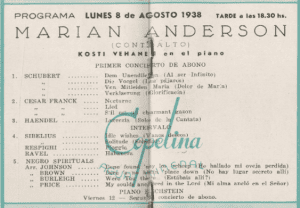I cannot believe we have reached the halfway point of our month-long DUR course. There are only two more weeks to gather and finalize data before sending our maps out into the growing world of digital humanities. In order to learn more about the spread of H. T. Burleigh’s influence, Jacob and I are researching where Marian Anderson, Paul Robeson, and Roland Hayes performed his works in their recitals. I am specifically focusing on Marian Anderson, who performed thousands of concerts in hundreds of cities. While researching, I have come across some challenges. With such a broad scope of performance history, which recitals do I include without unconsciously showing bias? I also came across the difficulty of mapping her time abroad with the available resources.
The research process was made exponentially better by Beth Christensen, St. Olaf’s very own music librarian. She compiled a research guide full of newspaper, primary source, and archival databases for us to research our hearts out. I have been relying mostly on Newspaper Archive and Proquest’s Historical Newspapers for online sources. Newspapers are difficult to work with because you’re not always dealing with helpful or complete information, as opposed to a physical program which displays date, venue, and repertoire. Unfortunately, most physical programs are locked away in archives. With time and budget constraints, it’s simply not feasible to fly out to the University of Pennsylvania and collect all the information from the beautiful programs hidden away in their archive on Marian Anderson. Coincidentally enough, they are in the process of digitizing her programs for the public. Although this iteration of the Burleigh Project will not be able to reap those benefits, it’s good to note for further research.

“Politama Argentina.” Marian Anderson Collection, MS 068. WCSU Archives, 15 Jan. 2019. Accessed on the Web: 15 Jan. 2019.
I have made a few exciting discoveries while researching. I have been in correspondence with a couple of places that have archives of Marian Anderson’s programs, such as West Connecticut State University (WCSU) and Wigmore Hall. Their sources have supplied data unavailable elsewhere, for example, WCSU had the complete program of Marian Anderson’s recital in Buenos Aires, Argentina. This was super exciting because it allowed me to confidently put Anderson’s performance of Burleigh’s Were you there? (a fitting title) on the map! Archival materials are important for research because they can tell you what other resources can’t. I selfishly hope more institutions will publicize their digital archives for students, researchers, and scholars to further increase the information available.
Before we consolidate our map, I need to figure out what information to discard. Do I get rid of every source that mentions spirituals but not Burleigh? That would get rid of any non-Burleigh performances, but it may also exclude performances where Burleigh works were performed. I am also struggling to find complete information from Anderson’s travels abroad. I know when and where she was, but Burleigh is hardly ever mentioned. I don’t want to compromise promising data because of a lack of information. This visualized for me the bias and prejudice against black composers of the 20th century. The articles in newspapers would list off works and credit composers such as Schubert and Beethoven in Anderson’s recitals, but they would group multiple song arrangements by different composers, such as H. T. Burleigh, Florence Price and Hall Johnson, into a one-word description of “Spirituals,” continuing the erasure or concealment of black composers from music history.1
I am happy with the findings we have so far, but there’s still a lot more work to do. Although the challenges have been frustrating, seeing the data start to come together is quite rewarding. The frustrations will all be worth it in the end. While I don’t think this work will ever fully be complete because there will always be more performers and performances to add, it’s exciting to see the global spread of Burleigh’s work just by looking at the performances of one singer. Research is exhausting, but it’s also exhilarating.
You must be logged in to post a comment.